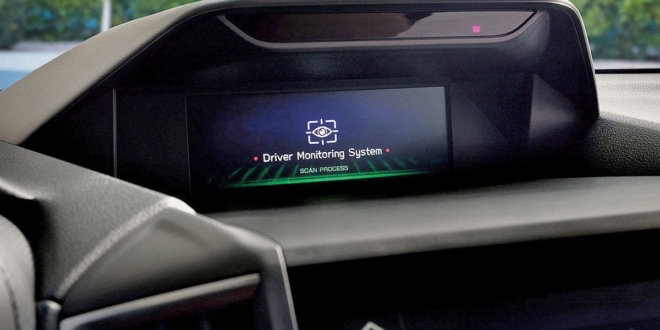
A Subaru cockpit with DriverFocus uses a camera above the infotainment system and sends an alert when it senses driver distraction.
A small infrared camera is above the infotainment system of the top trim of the redesigned 2019 Subaru Forester.
Assuming drivers are behaving, alert and operating distraction-free, they likely won’t even notice it. But it will be there watching them, all the same.
That’s the heart of what Subaru calls DriverFocus, a driver monitoring system that uses facial recognition software to identify signs of distraction and fatigue. The technology represents a field that is expected to explode in the coming years, with automated safety systems watching vehicle occupants to protect them from their own mistakes and failings.
In the Forester, once the camera has scanned the driver’s face, the system keeps track of his or her eyes. If the driver gazes into space or otherwise looks away from the road for two to three seconds while the vehicle is moving, the system emits audible and visual alerts to remind the motorist to focus on the road.
Mitsubishi Electric is the supplier behind DriverFocus, and the Forester is the first production vehicle to use its version of the technology.
Facial recognition software is beginning to flow into more aspects of daily life, such as Face ID on newer iPhones. But a wide spectrum of entities from social media platforms to airlines and even the Transportation Security Administration are also testing the technology.
Subaru is not alone in monitoring drivers.
Cadillac’s Super Cruise semi-autonomous highway driving system on high-end trims of the 2018 CT6 has an infrared camera system that monitors driver alertness. Eventually, General Motors plans to expand Super Cruise to all of its vehicles in the U.S.
BMW’s redesigned 2019 X5 crossover uses facial recognition technology in the form of a camera mounted in the instrument cluster, which checks to see that the driver’s eyes are open and facing the road. BMW’s driver-facing, camera-assisted , part of a $1,700 package, will be available in December. The technology will gradually roll out across BMW’s lineup.

Privacy?
Subaru and Mitsubishi Electric are quick to point out that DriverFocus does not record data, which has become controversial for some, when it comes to privacy concerns.
“This product does not record data,” Mark Rakoski, vice president of advanced mobility at Mitsubishi Electric Automotive America, makes clear. “It only operates in real time and analyzes whether the person is distracted or not. Going forward, obviously, whether it’s Subaru or other automakers, there can be an option to record. But the privacy concerns, or those buy-ins for the customer, must be managed.”
Rakoski believes consumers are ready for this sort of technology in their vehicles, pointing to his iPhone as evidence.
“I use the facial ID and I love it,” he said. “Little by little, we’re coming to grips with what’s private and what we want to turn on and off as consumers. Intuitively, it starts to make sense that if you’re accepting it on your phone, that you’ll accept it in the vehicle.”

Rakoski
Lots of algorithms
Developing the technology required enabling the system to recognize all kinds of people in any number of situations, Rakoski said. It involved a vast amount of algorithm work at the Japanese supplier’s test center in Northville, Mich., as well as in Europe and Asia. It included testing based on different ethnicities, people of various ages, identical twins, subjects wearing glasses and sunglasses and without glasses, the presence of beards and the facial changes that occur when a driver takes a sip of morning coffee.
“There’s a million cases with all types of demographics,” he said. “I believe we’ve done an excellent job at getting high accuracy.”
Developers also accounted for the camera’s different views. It considered various steering wheels, changing seat positions, whether the vehicle is an SUV or a car, and how facial expressions appear at sundown, as lighting changes, or in rainy conditions.
“It’s going to work in light or dark conditions, or if the driver is wearing glasses,” Rakoski said. “There’s sort of those edge cases where you’re wearing sunglasses but there’s a high glare of sun coming into the glasses at just the perfect angle. It starts to get a little more difficult and eventually those errors could be a little bit more frequent. But we’re testing all of those edge cases as much as possible and continue to improve.”
More coming
While the Forester is the first production model to use Mitsubishi Electric’s technology, more vehicles are coming soon, Rakoski said, declining to specify the brands.The supplier has contracts with two other automakers, he said.
DriverFocus was developed as a safety feature, but once the cameras and computers are in place in a vehicle, they open up new technology possibilities.
For example, it can be the building block for cabin monitoring — including rear-seat activity. That is something Rakoski says his company is interested in exploring.
“We don’t see any slowdown,” he said. “It’s going to become standard over time. We see more cameras and more use cases in the vehicle going forward.”
